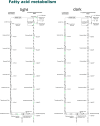Peculiar proteome of dark-cultivated Euglena gracilis
- PMID: 40670614
- PMCID: PMC12267456
- DOI: 10.1038/s41598-025-11308-z
Peculiar proteome of dark-cultivated Euglena gracilis
Abstract
Euglena gracilis is a flagellate photosynthetic microalga that, thanks to its metabolic adaptability, can grow under both autotrophic and heterotrophic conditions. This adaptability makes euglena an interesting species for applied biotechnology. We focused on the proteome of E. gracilis cultivated in Cramer-Myers medium (supplemented with ethanol) in dark and light conditions. Cultures grown in the light showed a characteristic green coloration, while cultures incubated in the dark were bright yellow. When cultured in the dark, microalga showed reduced concentration of chlorophylls (a, b, and total) and carotenoids compared to cells cultured in the light. Conversely, there was an increase in proline content in the dark compared to light cultivation. Using proteomic approach, we revealed 162 differentially accumulated proteins in light- and dark-grown cells classified into 12 functional groups. Notably, alterations in the metabolism of fatty acids and amino acids, secondary metabolism, and accumulation of stress- and detoxification-related proteins in microalgal cells cultivated in darkness with ethanol as a carbon source may help euglena adapt to these conditions. Based on our results and literature, we hypothesize that vitamin B12 potentially plays an important role in light/dark metabolic switch, similarly as in bacteria.
Keywords: Adenosylcobalamin; Mixotrophy; Photosynthetic pigments; Proline; Stress; Β-oxidation of fatty acids.
© 2025. The Author(s).
Conflict of interest statement
Declarations. Competing interests: The authors declare no competing interests.
Figures





References
-
- Vesteg, M. et al. Comparative molecular cell biology of phototrophic Euglenids and parasitic trypanosomatids sheds light on the ancestor of euglenozoa. Biol. Rev.94, 1701. 10.1111/brv.12523 (2019). - PubMed
-
- O’Neill, E. C. et al. Euglena in time: evolution, control of central metabolic processes and multi-domain proteins in carbohydrate and natural product biochemistry. Perspect. Sci.6, 84. 10.1016/j.pisc.2015.07.002 (2015).
-
- Barsanti, L. & Gualtieri, P. Anatomy of Euglena gracilis. Handbook of Algal Science, Technology and Medicine, s. 61–70, (2020). 10.1016/B978-0-12-818305-2.00004-8
-
- Gu, G. et al. Metabolomics revealed the photosynthetic performance and metabolomic characteristics of Euglena gracilis under autotrophic and mixotrophic conditions. World J. Microbiol. Biotechnol.38, 160. 10.1007/s11274-022-03346-w (2022). - PubMed
-
- Hasan, M. T. et al. Comparative proteomics investigation of central carbon metabolism in Euglena gracilis grown under predominantly phototrophic, mixotrophic and heterotrophic cultivations. Algal Res.43, 101638. 10.1016/j.algal.2019.101638 (2019).
MeSH terms
Substances
Grants and funding
LinkOut - more resources
Full Text Sources

